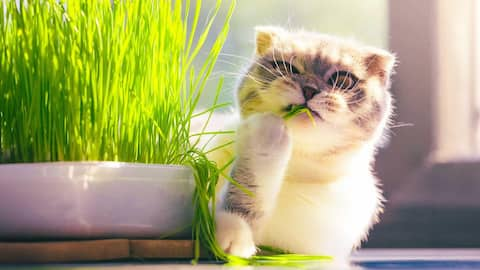How to grow nutrient-rich cat grass
What's the story
Cat grass, often referred to as "kitty grass," is a type of grass that is grown specifically for cats to nibble on. Grass serves as a natural dietary supplement for our feline friends, offering several benefits like aiding in digestion and also providing entertainment and stimulation. Let us understand what cat grass is and how to grow it to enhance your cat's overall well-being
About cat grass
What is cat grass?
Cat grass, unlike catnip from the mint family, is commonly grown from rye, barley, oat, or wheat seeds. Local pet stores offer various kitty grass kits containing seeds, soil, and a potting container. Cat grass is rich in essential nutrients, including vitamins, minerals, and fiber, which can help promote healthy digestion and prevent the formation of hairballs.
Difference
Catnip vs cat grass
While catnip, a member of the mint family, boasts aromatic oils that relax and excite cats, cat grass, comprising various grass types like rye, oat, barley, or wheat, offers a nutritious indoor snack. Cat grass provides health benefits, aiding digestion and providing stimulation, while catnip stimulates senses and encourages activity, making both valuable additions to your cat's environment.
Is it safe?
Benefits of cat grass
Cat grass offers a safer option than outdoor grass which might have pesticides, and acts as a healthy alternative to toxic houseplants and flowers. It allows your cat to engage in natural behaviors, satisfying their urge to nibble on vegetation. Indoor gardens offer cats a healthier option than pesticide-laden lawns, while providing them with a delightful taste of the outdoors.
How to grow- step 1
Select high quality seeds
Once you have selected high-quality cat-friendly grass seeds such as oats, wheat, barley, or rye, it is time to prepare the growing container. Opt for a shallow container with adequate drainage holes, ensuring excess water can escape easily. Whether it's a plastic or ceramic pot, a seedling tray, or a recycled shallow dish, the choice is yours.
Step-2
Laying seeds
Next, fill the container with potting soil or a soilless growing medium, leaving space below the rim to accommodate water. Ensure the soil is evenly moistened without being waterlogged. When it comes to planting the seeds, sprinkle them evenly over the soil surface, gently pressing them into the soil. Be generous with the seeds to create a dense carpet of grass.
Step-3
Germination
Use a spray bottle or a watering can with a fine nozzle to water the seeds gently. Aim to keep the soil consistently moist, but be cautious not to saturate it, leading to rotting seeds or mold growth. Choose a bright location with indirect sunlight to place your growing container. Direct sunlight can dry out the soil too quickly and scorch young seedlings.
Step-4
Sprouting
Keep up with regular watering to ensure the soil remains adequately moist. Within a couple of weeks, you should start to see the grass sprouting, and within two to three weeks, it will be ready for your cat to enjoy. As the grass grows, be mindful of its height. Once it is about three to four inches tall, trim it to encourage new growth.
